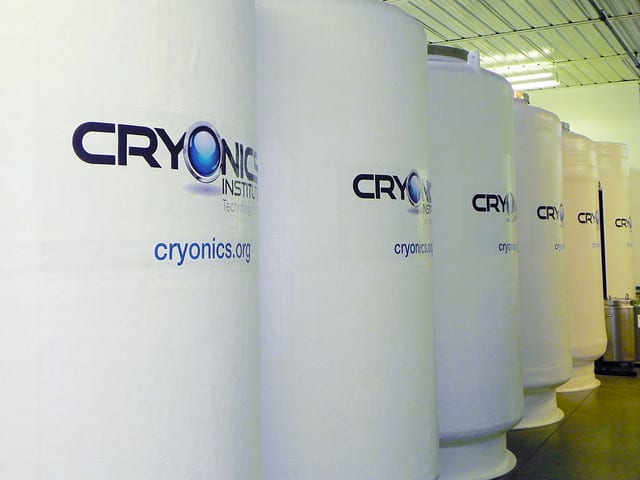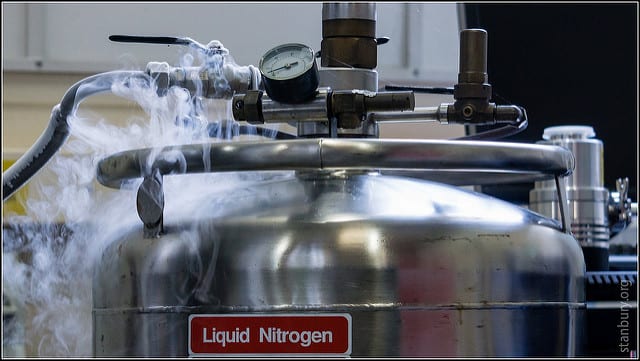
Recently, I was in the lab doing some routine work with cells. In order to start growing my own stock of cells I took a small vial out of a tank of liquid nitrogen, where it is stored at around -150°C (-238°F). Then I quickly thawed it to body temperature (37°C, or 98.6°F) and transferred it to a new dish where it began to grow. At some point during this process, I realized I had no idea why this actually worked. Is that scene in Return of the Jedi, where Han Solo gets thawed and is (mostly) fine, real? If I hop into this vat of liquid nitrogen, will you be able to pull me out in a hundred years? Armed with years of scientific training, I set off to find answers through careful research (i.e. Googling stuff that I don't understand).

A Brief History of Cryopreservation
The storage of biological material at ultra-cold temperatures, known as cryopreservation, is very real and routine in the research field. Scientists have been able to revive cryopreserved cells since the late 1940s. This was first accomplished by the Parkes group, who revived rooster sperm that had been frozen at -80°C. The technique has been crucial for maintaining important research cell lines, such as the famed HeLa cells and many engineered cell types. Essentially, many of the chemical reactions that age and degrade cells can be slowed to a near halt at low enough temperatures. This “freezes†the cells in time. The key to being able to revive the frozen cells lies in the addition of cryoprotectants.
Cryoprotectants are usually small molecules like glycerol or dimethyl sulfoxide (DMSO) that are able to diffuse into the cell and prevent the formation of ice crystals, which can destroy cells as they freeze. The expansion of ice rips apart the cells while also increasing salt concentrations to dangerous levels in the surrounding liquid.
Now, the big question is: can we freeze and revive an entire person? Believe it or not, research efforts for this are already underway. The cryopreservation of entire humans is called cryonics, and the first human to be cryonically frozen was James Bedford in 1967, whose body remains frozen to this day. James Bedford was a psychologist that suffered from an advanced form of kidney cancer. He opted to have his body cryopreserved upon his death in the hope that one day the technology would exist to revive him. Since then, many more people have paid large sums of money to be cryonically frozen upon their death by private companies, including baseball great Ted Williams. Many of these people suffered from advanced cancer or other incurable diseases and looked to cryopreservation as a final resort. The idea is that if they can stay frozen long enough, technologies will emerge that will allow them to be successfully treated when they are revived in the distant future.
Criticism of Cryonics: Cold Corpses Under Fire
To say that this approach is controversial would be greatly underselling it. One particularly scorching opinion from a neuroscientist states that, “those who profit from this hope [of being revived] deserve our anger and contempt.†Since there is no evidence that any brain activity is preserved after cryonic freezing, many believe that companies selling the idea are simply preying and profiting on the desperation of people trying to avoid death. One company called Alcor is funded using their clients’ life insurance, which deprives the families of much-needed funds after the death of a relative. Funerals are not cheap! Regardless of whether the technology to revive cryonically frozen humans will ever exist, it's likely that most attempts at cryonics were botched. Many of the frozen bodies could be irreparably damaged due to formation of ice crystals or long intervals between death and freezing.

Will cryopreservation of live humans ever be possible? It depends on who you ask, but there are a few that say the chances are “low, but not impossibleâ€.There have been cases of relatively simple organisms being revived after long-term freezing, but nothing as complex as a mammal. In my opinion, upcoming generations will have enough problems without having to worry about keeping Great-Great-Grandpa on ice. You're better off spending the time, money and resources helping someone who's still warm-blooded.
About the Author
 |
Trevor Adams is a Ph.D. Student in the Integrated Life Sciences program at the University of Georgia. He is interested in how the molecular bits of life shape our world. His hobbies include hiking, reading, and hanging out with his cat Bustelo. More from Trevor Adams. |
About the Author
- athenssciencecafehttps://athensscienceobserver.com/author/athenssciencecafe/April 17, 2020
- athenssciencecafehttps://athensscienceobserver.com/author/athenssciencecafe/April 12, 2020
- athenssciencecafehttps://athensscienceobserver.com/author/athenssciencecafe/April 3, 2020
- athenssciencecafehttps://athensscienceobserver.com/author/athenssciencecafe/March 30, 2020







